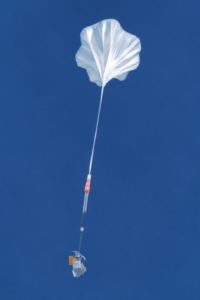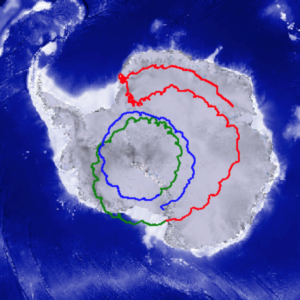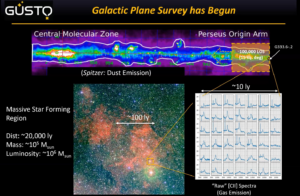Na een recordvlucht van 57 dagen, 7 uur en 38 minuten boven Antarctica voltooide NASA’s ballontelescoop GUSTO haar missie met een parachutelanding op het ijs. De missie was ontworpen voor 55 dagen in de lucht. GUSTO heeft spectra verzameld van gas- en stofwolken in onze Melkweg en een naburig sterrenstelsel met ver-infrarood camera’s, ontworpen door SRON en TU Delft.

GUSTO stijgt op op 31 december 2023 vanaf Antarctica. Credit: NASA
Sinds haar lancering op oudjaarsdag zweefde de Galactic/Extragalactic ULDB Spectroscopic Terahertz Observatory (GUSTO) mee met de circumpolaire vortex op 36-40 kilometer hoogte boven Antarctica. Tijdens haar 57 dagen in de lucht heeft ze een groot deel van de Melkweg en de Grote Magelhaense Wolk in kaart gebracht. GUSTO beschreef drie rondjes lang een buitenwaardse spiraal, voordat ze hoogte verloor. Terwijl de nacht steeds meer terrein won, vooral aan de buitenranden van het continent, waren hoogtedalingen onvermijdelijk, wat uiteindelijk leidde tot een verwacht einde van de missie. GUSTO had haar observatieplan toen al uitgevoerd.
‘We vieren een groot succes,’ zegt Jian-Rong Gao (SRON), de projectleider van de Nederlandse bijdrage. ‘GUSTO heeft enorm veel astronomische data verzameld vanuit de stratosfeer. En we zijn heel blij dat hij op het ijs is geland in plaats van in de oceaan. Dat betekent dat NASA hem gaat ophalen als de lente intreedt op het zuidelijk halfrond. Dat is eigenlijk niet nodig want alle data zijn al naar het grondstation verstuurd. Maar hij zou geweldig staan in een museum en sommige onderdelen kunnen zelfs hergebruikt worden voor toekomstige missies.’

Tijdens haar 57 dagen in de stratosfeer beweeg GUSTO zich mee met de circumpolaire vortex en completeerde drie rondjes om de zuidpool in een buitenwaardse spiraal. Credit: NASA
GUSTO is ontwikkeld om het stervormingsproces te ontrafelen—van de vorming van gas- en stofwolken helemaal tot het stervensproces van sterren en de aanwas van de nieuwe generatie sterren. Het observatorium bestaat uit een telescoop van één meter in diameter en een cryogeen instrument dat ver-infrarood camera’s heeft gebruikt om emissielijnen te detecteren van geïoniseerd koolstof (CII) en stikstof (NI) in het interstellaire medium (ISM)—het gas en stof tussen de sterren. De camera voor zuurstof (OI) heeft geen data verzameld vanwege onverwachte ijsvorming op de lokale oscillator—een referentiebron. Alle camera’s zijn gebaseerd op supergeleidende detectoren die werken bij -269 °C en zijn ontwikkeld door SRON in nauwe samenwerking met TU Delft.
‘Deze observatietechniek heet hoge-resolutie spectroscopie,’ zegt Wouter Laauwen (SRON). ‘Daarmee kunnen we uit de spectra de precieze dichtheid, temperatuur en snelheid herleiden van stofwolken. Dat maakt het mogelijk om een 3D-kaart te creëren van onze Melkweg en de Grote Magelhaense Wolk, waarmee astronomen hun modellen over stervorming en de evolutie van sterrenstelsels kunnen verifiëren en verfijnen.’

De eerste spectra van het koolstof (CII) kanaal, verzameld op 9 januari 2024. Credit: GUSTO Team
Balloon Telescope GUSTO lands on Antarctica after record-breaking flight
After a record-breaking 57 days, 7 hours and 38 minutes, NASA’s balloon telescope GUSTO completed its flight above Antarctica by landing on the ice by parachute. The mission was designed to last 55 days. GUSTO has observed atomic clouds in our own galaxy and its nearest neighbor with far-infrared cameras, developed by SRON and TU Delft.

GUSTO takes off on December 31st 2023. Credit: NASA
Since its launch on new year’s eve, the Galactic/Extragalactic ULDB Spectroscopic Terahertz Observatory (GUSTO) has floated along the circumpolar vortex at 36-40 km altitude above Antarctica. During its 57 days in the air, it has mapped a large part of our Milky Way, including the center, and a satellite galaxy called the Large Magellanic Cloud. Gusto has spiraled outwards for three orbits before losing altitude. As night was gaining more and more terrain, especially on the outer parts of the continent, altitude drops were inevitable and eventually caused an expected end of the mission. GUSTO had already completed its mission plan.
‘We are celebrating a huge success,’ says Jian-Rong Gao (SRON/TU Delft), the project leader for the Dutch contribution. ‘GUSTO has collected vast amounts of data during its 57 days in the stratosphere. And we are very happy that it landed on land rather than in the ocean. This means NASA can recover it when spring sets in on the southern hemisphere. Recovery is actually not necessary because all the data has already been transferred to the ground station. But it would be great for a museum and some parts could even be re-used for future missions.’
GUSTO is designed to unravel the star formation process—from the formation of gas and dust clouds all the way to the dying process of stars and the production of the next generation. The observatory consists of a one meter diameter telescope and a cryogenic instrument that used far-infrared cameras to detect and map emission lines of ionized carbon [CII] and nitrogen [NI] in the interstellar medium (ISM)—the gas and dust in between stars. The camera for oxygen [OI] failed to collect data because of unexpected ice-forming on the local oscillator—a reference source. All cameras are based on superconducting detectors operating at -269 °C and are developed by SRON in close collaboration with TU Delft.

During its 57 days in the stratosphere, GUSTO floated along the circumpolar vortex, completing three orbits in its outwards spiral around the south pole. As autumn set in and GUSTO moved closer to the edges of the continent, day/night temperature variations caused the observatory to lose altitude. The mission was designed to last 55 days. Credit: NASA
‘This observation technique is called high resolution spectroscopy,’ says Wouter Laauwen (SRON). ‘It allows us to extract from the spectra the exact density, temperature and velocity of atomic clouds. This makes it possible to create a 3D map of our galaxy and the Large Magellanic Cloud with which astronomers can verify and refine their models on star formation and galaxy evolution.’

First spectra from the Carbon [CII] channel, collected on January 9th 2024. Credit: GUSTO team


